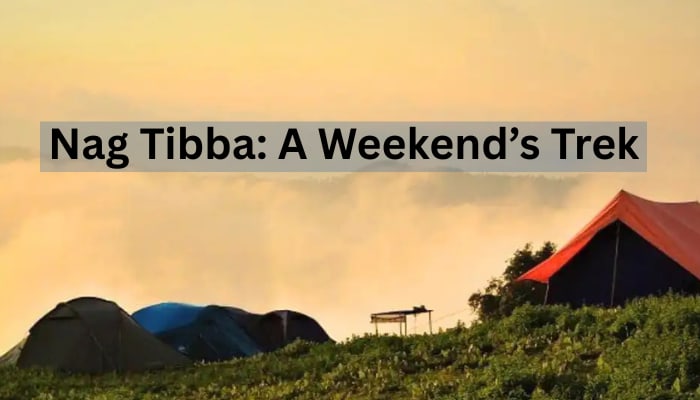For those who don’t have the luxury of weeks of planning or a long leave from work, Nag Tibba is a trek that’s hard to pass up when you need a quick escape. At 9,915 ft high, the peak of the Nag Tibba range in the Garhwal Himalayas, is the highest yet accessible to those who are pressed for time. This trek gives you the chance to leave the city behind, trade the rush for mountain silence and experience the joy of every step you take. It opens up a wider sky and is only possible in a single weekend.
The Nag Tibba trek starts from Pantwari in Tehri district of Uttarakhand. The Nag Tibba trek is one of the best weekend treks in Uttarakhand. It is a ridge peak and highest peak of lesser Himalayas . It offers views of Mussoorie and Vikasnagar and views of Himalaya peaks such as Bandarpuchh, and spurs of Yamuna river valley. The trek route of Nag Tibba takes you through dense forests and offers breathtaking views of the surrounding valleys. The Nag Tibba Trek is a must-do for all trekking enthusiasts and nature lovers who want to explore the beauty of the Trek.
Nag Tibba – Highlight
- A Summit of Nag Tibba: A short weekend trek could give you that last push toward a summit; it may feel just like the long Himalayan journeys, Kedarkantha included.
- Himalaya Views: Swargarohini, Bandarpoonch, Kala Nag, Srikanth, Gangotri, Kedarnath peak, Doon Valley, and even the shimmering Changabang.
- The trail: Dense oak and deodar forests, meadows, and ridge walk, all are in just this short trek.
- Accessibility: A four-hour drive from Mussoorie and Dehradun is essentially all that’s needed, and given the proximity to Delhi-NCR, this makes it an accessible option for many when planning a trek to Nag Tibba.
- Beginner-friendly: No prior experience required. A perfect first taste of the Himalayas.
Quick Itinerary
Day 1: Drive from Dehradun to Pantwari to Trek to Nag Tibba Basecamp
- Drive through the Massoorie hills and valleys from Dehradun to Pantwari with a distance of 100 km(3-4 hrs).
- Trek 4-5 km to the basecamp, walking past village trails and oak forests.
- Evening under the stars, wrapped in silence and mountain chill.
Day 2: Trek from Basecamp to Nag Tibba Summit to descend to Pantwari to drive to Dehradun
- After a 9 km trek from base camp to summit( 7506 ft ).
- 100-degree view of the Himalayas.
- Return to base, descend to Pantwari, drive back to Dehradun by evening.
How Does Each Day Look
Day 1: As you begin to see the pine forests, and the gentle rise of the hills, the stress of the world starts to melt away as you leave the city behind. After a small 10 km drive to goat village, it got deeper. Coming hotfooting along the trail at first to Khatian campsite, the trek gets off to a steady start, with the passing villages moving at a very relaxed pace. Oak, rhododendron and other trees provide the shelter and shade you need, and then, suddenly, you’ll see a beautiful meadow that is basically made for camping. Where the setting sun paints the sky orange and the Milky Way feels close enough to reach out and touch.
Day 2: The second day of trek , which is the summit day . In which you will walk on the ridge of Nag Tibba peak. After 2 km of trek at the base of Nag tibba there’s the temple of Nag Devta. Then the trek passes through thick forest and in winter trails get a bit difficult because of snow and as you walk forward the views of Gharwal himalayas start appearing, then after just 2 – 3 km hike at the summit you will witness a 100 degree view of mountain ranges. Make your all efforts worthy. Then on the same day trek back to village Khatian, drive back to Dehradun.
How Difficult Is Nag Tibba Trek
Nag Tibba is easy to moderate, depending on your fitness. The climb to the summit is short but steep, especially on Day 2. No technical gear is needed — just stamina, a steady pace, and the will to keep climbing. For a beginner, it’s a beautiful introduction. For an experienced trekker, it’s a refreshing weekend climb.
Best Time To Do Nag Tibba Trek
- Winter (Nov–March): In the winter season, trails covered in snow make the best snow adventure in a small vacation.
- Spring (April–June): Forests bloom, skies are clear, and the weather is pleasant.
- Autumn (Sept–Nov): In Autumn the spectrum hits clear skies, attracting photographers. Best for stargazing in clear skies.
- Monsoon (July–Aug): Not recommended. The trail gets slippery, and views stay hidden.
Every season paints Nag Tibba differently. In winter, it’s an adventure in the snow. In spring, it’s a gentle walk through green and bloom.
What To Carry on your Nag Tibba Trek
Always go with proper packing, right essentials.
- Clothes: Base layers, fleece, padded jacket, trek pants, gloves, warm socks.
- Shoes: Keep right trekking shoes.
- Gear: Keep rucksack of 40- 50 l, headlamp, trekking pole .
- Extras: Sunglasses, sunscreen, personal medicines, water bottle.
How To Reach Nag Tibba Basecamp
- Nearest city: Dehradun.
- From Delhi: Overnight bus/train to Dehradun/flight (6-7 hrs).
- From Dehradun: Drive to Pantwari village (~90 km, 3-4 hrs).
The trek begins from Pnatwari. Local taxis are easily available from Dehradun.
Stay Options for Nag Tibba Trek
- Camping under the stars: Most trekkers stay in tents set up at basecamp or higher meadows.
- Homestays in Pantwari: Cozy, local options before/after the trek. If you want to explore villages.
- Hotels in Mussoorie or Dehradun: If you want comfort before heading back home.
How to Get Fit for the Nag Tibba Trek
The trek may be short, but still basic fitness is important.
- Cardio: Jog or walk 3-4 km daily.
- Leg strength: Squats, lunges, stair climbs.
- Practice: Try carrying a small backpack on walks — it builds stamina.
Even a week or two of preparation makes the trek much smoother.
Frequently Asked Questions
1. Is Nag Tibba safe for first-time trekkers?
Yes. The trail is well marked, short, and often trekked. Guides are available at Pantwari.
2. Will I see snow?
Yes, from late December to March. The summit is often snowbound in these months.
3. How long does the trek take?
2 days. If you’re short on time, it can be done as a single-day push.
4. Can families or kids join?
Yes, children above 8 with basic fitness can manage this trek.
5. Why is it called Nag Tibba?
Locals believe this hill is the abode of Nag Devta (the serpent god). A small temple dedicated to him lies on the
Har ki dun trek also is one the most renowned winter treks in Uttarakhand, India.



